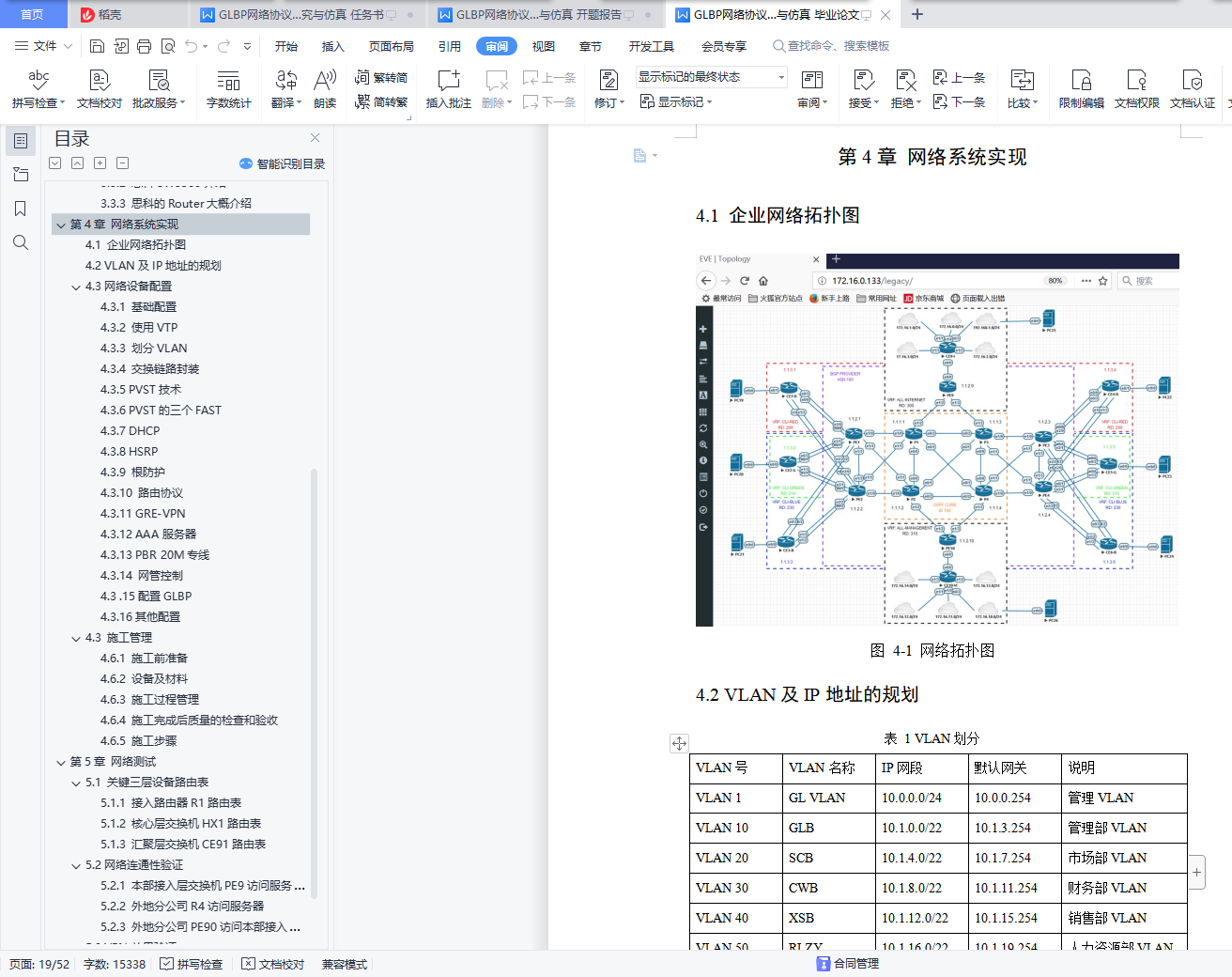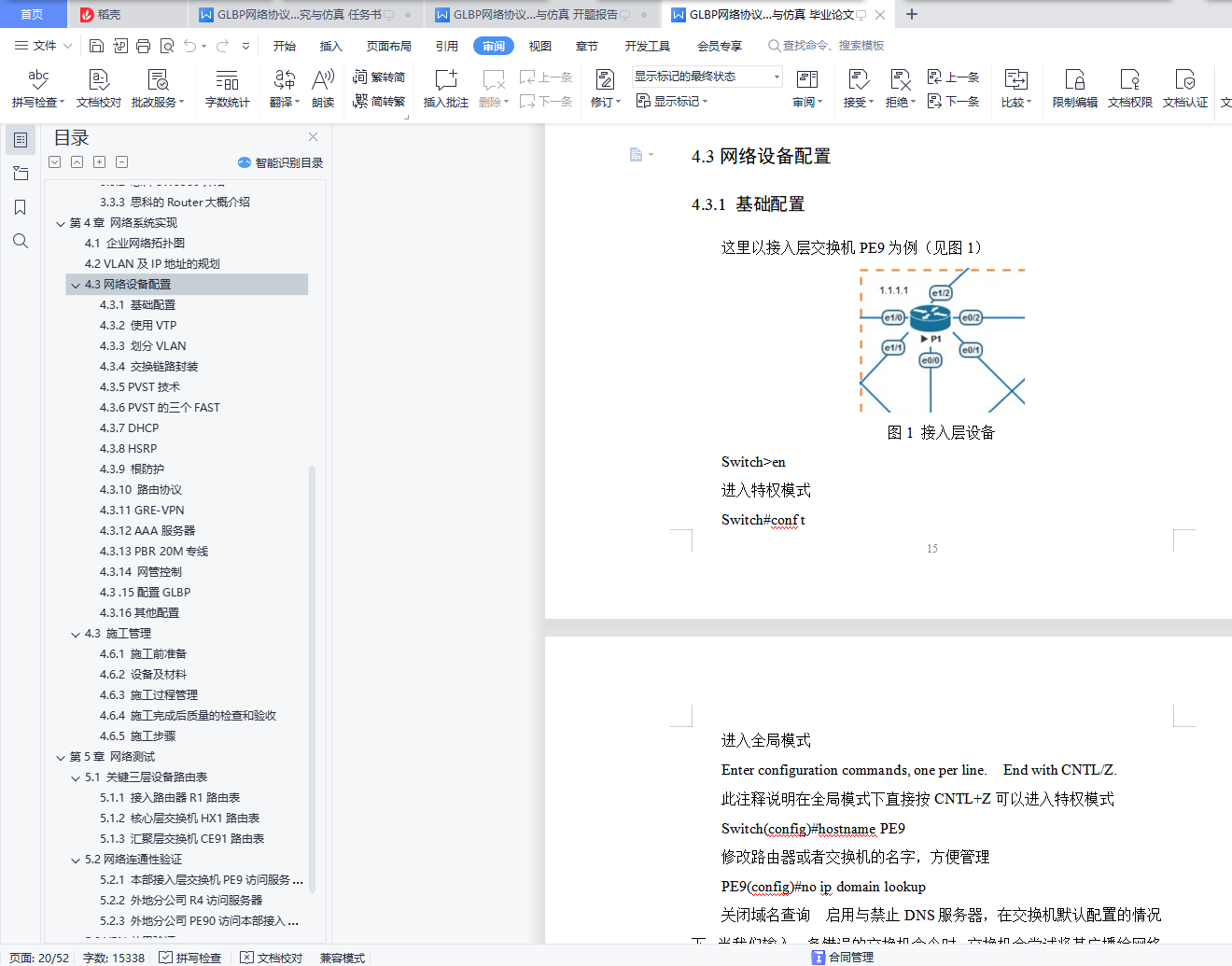摘 要
随着网络技术的快速发展,网络与人们的生活越来越贴近,人们对网络稳定性要求也越来越高。企业网设计与架构的要求考虑到冗余备份的放置使用,每个部门虽然相互独立,且需要相互进行联系,核心层设备要实现快速收敛,网关快速切换,骨干区域要快速、高效转发数据流。内网与外网要稳定、安全。
为了提高网络的稳定性,以及减少因网络设备发生故障导致的网络瘫痪而造成不必要的经济损失,本文采用GLBP协议来解决路由器的冗余备份和负载均衡的问题。通过分析企业网的网络结构,研究GLBP原理,运用EVE-NG软件搭建一个企业网络拓扑,进行相关配置,实现冗余备份。
在网络协议方面采用GLBP协议(网关负载分担协议),不仅可以解决设备资源不能充分利用的问题,同时可以解决网络的高可用性问题。本次设计详细介绍GLBP技术的原理以及实际应用,讨论GLBP的应用模式,并且给出实际部署的基本拓扑图。
关键词:GLBP;网络协议;拓扑图;网关负载;EVE-NG
Abstract
With the rapid development of network technology, the network is more and more close to people's life, and people's requirements for network stability are becoming higher and higher. The requirements of enterprise network design and architecture take into account the placement and use of redundant backups. Although each department is independent of each other and needs to be connected with each other, the core layer equipment should realize rapid convergence, the gateway should switch quickly, and the backbone area should forward the data stream quickly and efficiently. The intranet and extranet should be stable and safe.
In order to improve the stability of the network and reduce the unnecessary economic loss caused by the network paralysis caused by the failure of the network equipment, the GLBP protocol is used to solve the problem of redundant backup and load balancing of routers. Through analyzing the network structure of enterprise network, studying the principle of GLBP, using EVE-NG software to build an enterprise network topology, carrying out related configuration, realizing redundant backup.
Adopting GLBP protocol (gateway load sharing protocol) in network protocol can not only solve the problem that equipment resources can not be fully utilized, but also solve the problem of high availability of network. This design introduces the principle and practical application of GLBP technology in detail, discusses the application mode of GLBP, and gives the basic topology diagram of actual deployment.
Keywords: GLBP; network protocol; topology diagram; gateway load; EVE-NG
目 录
摘 要
Abstract
第1章 绪论
1.1选题背景及目的意义
1.1.1选题背景
1.1.2目的及意义
1.2发展现状及趋势
1.2.1研究现状
1.2.2发展趋势
1.3研究主要内容
第2章 需求分析
2.1需求分析
2.2可行性分析
2.3使用方案
2.4本章小结
第3章 总体设计
3.1企业网络整个架构
3.2技术的选择
3.2.1 接入层的技术选择方案
3.2.2 汇聚层的技术选择方案
3.2.3 核心层的技术选择方案
3.2.4网络安全技术选择方案
3.3设备的选型
3.3.1 思科SW2960介绍
3.3.2 思科SW3560介绍
3.3.3 思科的Router大概介绍
第4章 网络系统实现
4.1 企业网络拓扑图
4.2 VLAN及IP地址的规划
4.3网络设备配置
4.3.1 基础配置
4.3.2 使用VTP
4.3.3 划分VLAN
4.3.4 交换链路封装
4.3.5 PVST技术
4.3.6 PVST的三个FAST
4.3.7 DHCP
4.3.8 HSRP
4.3.9 根防护
4.3.10 路由协议
4.3.11 GRE-VPN
4.3.12 AAA服务器
4.3.13 PBR 20M专线
4.3.14 网管控制
4.3 .15配置GLBP
4.3.16其他配置
4.3 施工管理
4.6.1 施工前准备
4.6.2 设备及材料
4.6.3 施工过程管理
4.6.4 施工完成后质量的检查和验收
4.6.5 施工步骤
第5章 网络测试
5.1 关键三层设备路由表
5.1.1 接入路由器R1路由表
5.1.2 核心层交换机HX1路由表
5.1.3 汇聚层交换机CE91路由表
5.2网络连通性验证
5.2.1 本部接入层交换机PE9访问服务器
5.2.2 外地分公司R4访问服务器
5.2.3 外地分公司PE90访问本部接入交换机
5.3 VPN效果验证
第6章 总结
致 谢
参考文献











